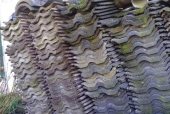
 7
7





 8
8




For all your Montana Masonry Heater parts (also known as) Rocket Mass heater parts.
Visit me at
dragontechrmh.com Once you go brick you will never go back!
 6
6





 3
3




Proudly presenting RocketMassHeaters.com
A good starting point to all RMH research
How Permies.com works
 7
7





 7
7




 6
6




 6
6





 6
6





 3
3




 3
3




 1
1









Glenn Herbert wrote:I built my bell from old red clay bricks laid up on their sides, covered by an outer skin of cob (about 6"/15cm). I did use firebrick for the top third and ceiling; red clay brick may not last as long, but if given generous clearances to the riser top should be good for many years.
6" is the upper limit of cob thickness I would recommend, as that takes several hours for the heat to start coming through and heating the room. 4"/10cm would probably be the best balance for mass and heat transmission considerations.

 2
2





 1
1




Glenn Herbert wrote:I don't think the top is the best location for a radiant panel, though; it would be sending heat up to the ceiling, not out into the space where people could quickly feel it. I would set an access panel into a face of the bell, to serve two purposes: instant heat directly to the room occupants, and easy access for inspection, maintenance and repair of the combustion core without having to dismantle brickwork. A steel angle frame anchored to the masonry, with a flat steel panel screwed into it, works excellently in my experience.

 2
2





|
Those are the largest trousers in the world! Especially when next to this ad:
The new purple deck of permaculture playing cards
https://www.kickstarter.com/projects/paulwheaton/garden-cards
|






